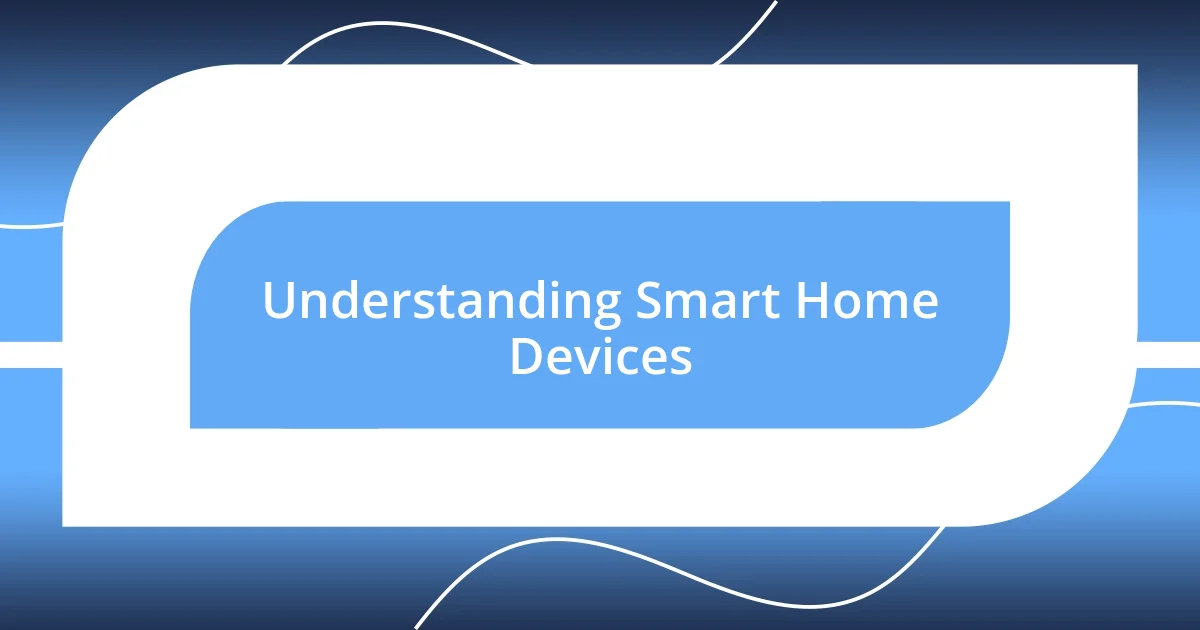Key takeaways:
- Starting with a single device, like a smart speaker, can effectively ease the transition into smart home technology and enhance daily convenience.
- Choosing the right smart hub is crucial for compatibility and user experience, influencing the overall functionality of your smart home ecosystem.
- Integrating smart features gradually, such as security devices and automation, significantly enhances comfort and efficiency in managing your home.

Starting with Smart Home Tech
Starting my journey into smart home tech felt a bit overwhelming at first. I remember standing in the store, overwhelmed by the endless options and gadgets. Have you ever felt that way? It’s like stepping into a tech wonderland, but that sense of excitement can quickly turn into confusion.
I decided to start small—beginning with a smart speaker. This simple device transformed my daily routine in ways I never expected. I could play music, control my lights, and even ask about the weather, all with just my voice. The initial joy of setting it up was like discovering a new hobby. The best part? It genuinely made my life more convenient and fun!
As I gained confidence, I explored other smart devices, like smart bulbs and plugs. Each addition opened new possibilities and turned my home into what felt like a personal tech sanctuary. Have you thought about what you might want to add to your own space? Starting with just one or two devices can lead to greater comfort and creativity in your home life.

Understanding Smart Home Devices
Understanding smart home devices can feel like navigating a maze, especially when you’re just starting out. I vividly recall my first experience with a smart thermostat—walking into my home after a long day and feeling an instant cozy warmth that I had pre-set from my phone. It was a simple yet profound realization: I could adjust my home environment from anywhere, tailoring my space to my preferences with just a tap on my phone.
Here’s a breakdown of the core types of smart home devices:
- Smart Speakers: Voice-activated assistants that can play music, control other devices, and answer questions.
- Smart Lights: LED bulbs that can be adjusted remotely to change brightness, color, and schedules.
- Smart Thermostats: Devices that learn your heating and cooling preferences, optimizing energy usage.
- Smart Security Cameras: Cameras that offer live feeds and alerts for unusual activity, enhancing home security.
- Smart Plugs: Outlets that allow you to control non-smart devices via an app or voice commands.
Each device brings its own unique benefits, often simplifying tasks and enhancing our day-to-day lives in ways we didn’t realize were possible. I know I was thrilled the first time I dimmed my living room lights for movie night without having to get up—like having my own personal butler!

Choosing the Right Smart Hub
Choosing the right smart hub can feel daunting, but it’s a crucial step in building your smart home ecosystem. When I was in the process, I spent considerable time comparing options that would seamlessly integrate with my existing devices. I found that compatibility was a key factor— I wanted a hub that could connect to various brands without being picky. Have you ever used a device that just wouldn’t work with your other tech? It’s frustrating, to say the least!
In my experience, the user interface of the smart hub also plays a significant role. A complicated app can turn a simple task into a headache. I remember grappling with my first hub’s clunky interface, wishing for something more intuitive. Finding a hub that offered both ease of use and robust functionality really made all the difference for me in the long run. I recommend trying to visualize how often you’ll interact with the hub. You want a hub that feels effortless, an extension of your thoughts rather than an obstacle.
Lastly, price considerations played a part in my decision. There’s a wide range of hubs from budget-friendly models to premium options with all the bells and whistles. I quickly learned that sometimes, spending a little extra means getting a feature-rich hub that will serve me well for years. What’s your budget looking like? Remember, investing in a quality smart hub at the beginning can save you hassle down the line.
| Smart Hub | Compatibility |
|---|---|
| Amazon Echo Plus | Works well with Alexa-compatible devices |
| Google Nest Hub | Best for Google Home devices |
| Samsung SmartThings Hub | Broad compatibility with various brands |
| Aqara Hub | Ideal for Zigbee devices |

Setting Up Your Smart Home
Setting up your smart home can be an exciting yet overwhelming experience, especially if you’re not sure where to start. I remember when I first unboxed my smart lights; they seemed so simple yet held such potential. It’s like stepping into a new world where every little detail is customizable—but what’s the best way to begin? I found that mapping out a plan helped. Prioritize which areas of your home need smart technology the most, whether it’s for convenience or security.
Next, I learned the importance of ensuring a strong Wi-Fi connection, as it’s the backbone of any smart home setup. I vividly recall the frustration of having devices frequently disconnect from the network, derailing my perfectly scheduled lighting scenes and thermostat adjustments. Make sure your router can handle multiple devices at once, or consider investing in a mesh Wi-Fi system for better coverage throughout your home. Don’t you want to enjoy the benefits without constant interruptions?
As you dive in, integrating devices gradually can make the transition smoother. I started with my smart speaker, which laid the groundwork for future devices to connect effortlessly. It offered both functionality and control—before I knew it, I was commanding my lights and thermostat all through voice commands. This approach not only kept me from feeling overwhelmed but allowed me to enjoy the process of building my smart home at my own pace. What about you? Have you thought about how you will introduce these conveniences into your daily life?

Integrating Smart Home Features
Integrating smart home features has been a transformative experience for me. One of my first integrations was linking my smart thermostat to my voice assistant. It felt like magic! I could simply say, “Hey Google, set the temperature to 72 degrees,” and just like that, my home responded. That instant gratification got me hooked on the simplicity and elegance of a connected home.
As I continued to add more devices, I discovered the power of automation. For instance, I programmed my smart lights to turn on automatically at sunset. The first time I walked into my home and was greeted by warm, inviting light made me feel a bit spoiled— and honestly, I loved it! It rarely occurred to me that I could orchestrate my environment so effortlessly. Have you thought about how automation could enhance your daily routine?
Keeping everything running smoothly is key, and I quickly realized that a well-managed smart home hub is invaluable. When I experienced disconnection issues with my devices after a few weeks, it felt like a setback. But, by spending a little time organizing my settings, I learned to troubleshoot common problems. Now, I often think, “What’s the next feature I can seamlessly integrate?” This ongoing process is not just about convenience; it’s about enhancing the comfort and efficiency in my everyday life.

Enhancing Security with Smart Tech
One of the most impactful upgrades I’ve made to enhance my home security is installing smart doorbell cameras. The first time I received an alert on my phone that someone was at my door, I felt a wave of relief wash over me. Being able to see, and even speak to, visitors without having to open the door was empowering. Isn’t it great to have that kind of control at your fingertips?
Pairing my doorbell camera with motion sensors was another game-changer. I remember nights when I’d hear an unusual noise and instantly check my app. Seeing a raccoon rummaging through my trash instead of a potential intruder reduced my anxiety tenfold. These devices not only safeguard my home but also bring peace of mind, knowing that I’m aware of my surroundings even from miles away. How reassuring is it to know that you can keep an eye on things, no matter where you are?
The integration of smart locks further solidified my security setup. I vividly recall the first time I locked my front door remotely while lying in bed; it was a moment of pure convenience. No more fumbling for keys! Plus, with features that allow me to grant temporary access to guests or service providers, I felt a new level of trust and flexibility in my home. Have you considered how these smart security solutions could simplify your life while keeping your loved ones safe?

Troubleshooting Common Smart Home Issues
When I first started using smart home devices, my Wi-Fi connection became a significant hurdle. A few times, my smart thermostat just wouldn’t respond, and it left me feeling frustrated. I quickly discovered that placement is key; devices need to be within range of my Wi-Fi router. Now, I make a habit of checking my network before I panic, and it has saved me from a few unnecessary headaches.
Another common issue I encountered was with voice command responsiveness. There were moments when I’d ask my voice assistant to do something, and it just sat there, silent. It made me question whether my assistant was listening. After a bit of trial and error, I learned the importance of speaking clearly and ensuring the device was updated. It’s surprising how a simple software update can resolve connectivity glitches and improve functionality. Have you ever found yourself talking to a device and wondering if it’s just in a mood?
I also faced the dreaded problem of devices not recognizing each other. I remember trying to set up my smart lights to sync with my thermostat, with results that would leave anyone scratching their head. To troubleshoot, I found it helpful to revisit my app settings and ensure compatibility. Sometimes, a reboot is all it takes to get things communicating smoothly again. I now feel more confident in my ability to troubleshoot these issues because I realized it’s all part of the journey toward a truly smart home.












